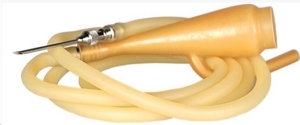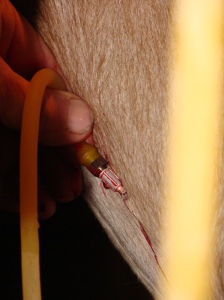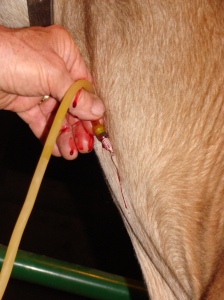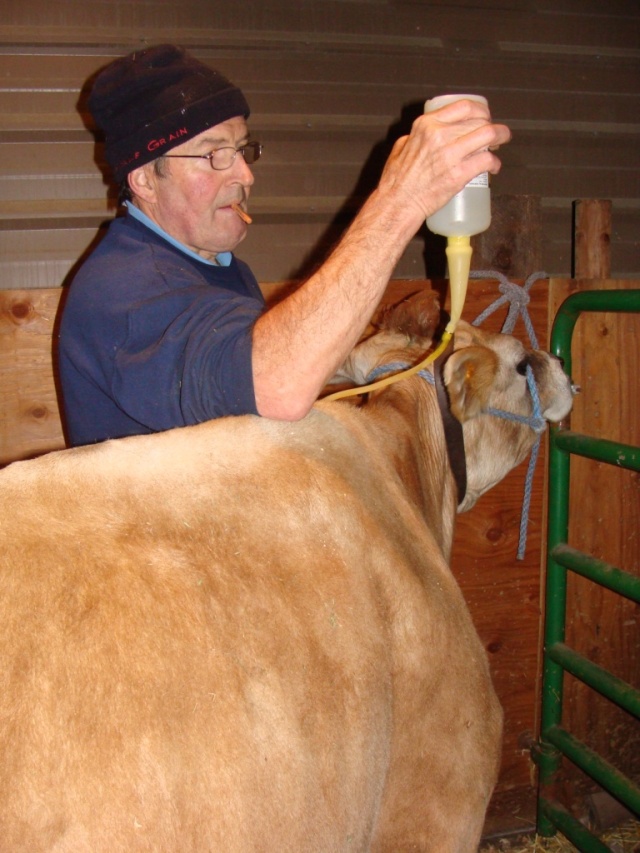 Milk Fever is caused by an imbalance occurring generally in the day or so after calving (sometimes before calving). When a cow goes from being dry (not milking) to lactating (milking), her body stimulates a drastic draw of calcium out of body for the purpose of lactation (secreting milk, high in calcium), particularly in high producing dairy cattle.
Milk Fever is caused by an imbalance occurring generally in the day or so after calving (sometimes before calving). When a cow goes from being dry (not milking) to lactating (milking), her body stimulates a drastic draw of calcium out of body for the purpose of lactation (secreting milk, high in calcium), particularly in high producing dairy cattle.
Click to watch our two part video on identifying and treating milk fever. Apologies in advance, we were borrowing the camera… but the commentary is informative and worth listening to in addition to what is written below.
Here’s another good 7 minute video about treating milk fever: https://www.youtube.com/watch?v=6UECnnkdq6o&feature=youtu.be
Milk fever may include an imbalance in other nutrients, which is why IV CMPK (for Calcium – Magnesium – Phosphorus – Potassium) sometimes works better than IV Calcium/Dextrose alone. *Some vets have the ability to test for blood levels of C-M-P and K to help assist in problem solving the issue. If initial treatment of Calcium helps the cow perk up, but she later goes back down or gets bad again, then it’s likely the issue is Calcium plus M, P, and/or K.
First time calving cows rarely get milk fever and the incidence of milk fever tends to increase with age as milk production tends to also increase with age. If cows are not “pushed” to produce a lot, age may not become much of a factor in likelihood of occurrence. Any high producing cow, particularly a cow that is producing a lot of milk in comparison to her overall body size, is at higher risk.
When identifying milk fever, carefully check the many symptoms of milk fever. For example, occasionally, a cow will be unable to rise after calving due to a pinched nerve. This will heal over time and requires different treatment than milk fever. Other possibilities of a cow “going down” around calving time are: selenium deficiency or various causes of toxemia. If a cow goes down a couple weeks after calving, check for symptoms of KETOSIS. If a cow goes down at calving but milk fever treatment is not working, check for symptoms of FATTY LIVER.
 Signs:
Signs:
- constipation (because they may stop eating properly during calving process),
- unable to stand or walks drunkenly,
- cold ears and tailhead,
- dry nose,
- eyes sunken in,
- bloated,
- head curled in toward body tightly or laying flat in worst cases.
Prevention:
- Always keep on hand for emergencies:
- IV kit with new, sterile needles (kit comes with one, buy a few extra 14 or 16 gauge):

- At least one bottle each of IV solution for: CMPK (Rx), Calcium, and Dextrose
- Recommended: Bovikalc bolus or similar CMPK boluses, gel, etc.

- IV kit with new, sterile needles (kit comes with one, buy a few extra 14 or 16 gauge):
- Limit feeding of alfalfa hay during dry period (30% of diet, approximately). Alfalfa is high in calcium and potassium, both of which are not needed much during the dry period and can cause milk fever issues at calving time. Reinstate about a week before calving and gradually work back up to full levels of alfalfa feed.
- Feed more mature hay of adequate quality OR find hay from a farmer that tests forage and buy a hay low in calcium and potassium that are still palatable. Feeding long-stemmed fiber is important.
- Maintain adequate nutrition throughout dry period. (See body condition charts and ask knowledgeable people to determine your cow’s condition. She should be between 3 and 4 on body score.) A cow too thin or too heavy is at increased risk.
- CMPK boluses or calcium propionate paste before calving at intervals as instructed on packaging. Note: Calcium paste and gels may be caustic!
- Doses of Vitamin D before calving.
- Feed a dry cow mineral rather than a lactating cow mineral. Limit phosphorus.
 Treatment options:
Treatment options:
- The key to milk fever is to increase calcium supply in the blood system. Additional goal is to get her drinking, standing up, eating, and having bowel movements in order for her system to reset and improve.
- Always make sure the cow is at least laying upwards, with her shoulders up under her head. Prop her up with a bale of straw if you have to, but make sure she is upright.
- Cow will most likely be in a calving area, and should be on a bedded pack (layers of straw and shavings to the depth of 1 foot or more) that can still allow the cow to get goof footing for when she attempts to stand up.
- Prepare one bottle of CMPK or calcium gluconate and one bottle of Dextrose by warming them in a bucket of hot water. Administer slowly (10-20 minutes) one bottle of Calcium/CMPK in vein and then one bottle of Dextrose IV for added energy. (Many vets do not see the need for extra Dextrose, but in our experience, the extra energy is very helpful for cows to get well sooner.) CLICK HERE for GIVING AN IV
- Want to give it sub Q? If you are unable to or terrified to give an IV, Merck notes Sub Q is sometimes used. The Calcium should be given in small doses per injection location. (I can’t find the exact amount) Please read up on this further if you are concerned. “Recommended treatment is IV injection of a calcium gluconate salt, although SC and IP routes are also used.” Quoted from MERCK – Parturient Paresis
 Encourage cow to drink by bringing her a dish of lukewarm water.
Encourage cow to drink by bringing her a dish of lukewarm water.- Allow the cow a few hours before determining if further treatment is necessary, but keep a close watch on the cow at regular intervals. A sick cow can deteriorate at a very quick rate!
- If you have to give three bottles over the first day and she is still not improving, give Equiphar and make sure they have 7-10 gallons of temperate water within reach. This should encourage her to drink some water on her own.
- DO NOT ever drench a cow unless absolutely necessary. Even the most experienced people should avoid this tactic, as it is easy to get the fluids into the cow’s lungs rather than her digestive system. We have heard of cows dying from drowning and it is heartbreaking to hear that it could have been prevented if they just had not drenched the cow. There are other ways to get a cow to drink on her own!!
- Continue to milk the cow on a normal schedule if possible. The concept of partial milking has less benefits than it does health risks and should not be done.
Should we really be afraid of milk fever??
Yes and No – Prevention goes a long way!
A 10 year old cow of ours calved one January on a frigid zero degree windy day. She’s prime candidate for milk fever in the classic reasoning: old lady, genetically made to give a lot of milk for a cow her size, several days overdue, we weren’t feeding her grain, and were feeding her a mainly alfalfa diet.
So with all that against her, what did we do in her favor?
-
Soaked beet pulp – Carbs and fiber help maintain a healthy rumen and prevent constipation or diarrhea. (Gradually add to diet before calving, so they like the taste and will eat a lot at calving time)
-
Tempered molasses water – Tempered so she doesn’t have to expend energy to warm up the water once in her body. Molasses is high in minerals and provides energy.
-
Feed variety and quality – We feed both alfalfa and grass hays, high in quality and coming in first, second, and third cuttings for variety of taste and texture (fine leaves vs. long stems: fines are high in protein and long stems promote good rumen function.) Some people limit the amount of alfalfa their cows get during the dry period. Yeast has been found to really boost metabolism in cows.
-
Cow was not fat – keeps cows from collecting fat on their organs, which is going to cause metabolic complications that may promote milk fever. Having dry cows on pasture is a easy way to promote a healthy weight in the right seasons.
-
Minerals and salt always available in loose form and free-choice. There are dry cow and lactating cow minerals available in some areas.
-
Exercise – Cows need to walk, not just in a small pen, but out and about so they can maintain muscle strength and condition.
-
Fresh air – Our barn is as open as possible without letting in cold air or moisture. This allows sunshine in on warm days to dry the barn and always air flow to avoid stagnation.
-
Minimal stress – Calving stall is in the same barn as where the cows live – friends nearby, similar smells, and familiarity.
-
Monitor manure so it’s not too constipated or too runny at calving time.
Resources:
- VIDEO, Giving Calcium IV to a milk fever cow: http://www.youtube.com/watch?v=p7zMD0_wjq0
- Hoard’s Dairyman. “Fresh cow problems: How to control them.” http://www.agromedia.ca/ADM_Articles/content/freshcow.pdf
- K. Fred Gingrich II, D.V.M. “Why treatment protocols are so important.” http://www.hoards.com/E_animalhealth/aabp6
- New Mexico State University. “Controlling Milk Fever and Hypocalcemia in Dairy Cattle.” http://aces.nmsu.edu/pubs/research/dairy/TR31.pdf
- Nutritech Solutions Milk Fever Protocol: http://www.nutritechsolutions.com/assets/images/client/File/NutriCal/Suppl%20sheets/NTS%20fresh%20cow%20protocol.pdf
- Treatment Protocols, Wilson Dairy: http://wilsondairy.com/protocols.html#6
- Trouble-shooting milk fever and down cow problems: http://extension.psu.edu/animals/dairy/nutrition/nutrition-and-feeding/nutrition-and-health/trouble-shooting-milk-fever-and-downer-cow-problems





Hi,
we have just had our first experience of milk fever and nearly lost our house cow. She gave birth in the afternoon, all looked fine and the next morning she was on the ground, in a seriously distressed state, back legs paralysed and suffering from bloat. Thankfully the vet got here in time, and with a lot of care and intervention and being sure she stayed upright, by midnight that day she was back up and walking. We gave her calf to a foster mum beef cow and they are doing fine.
We have been advised to dry off the cow, not give her her calf back and not put her in calf again. I would appreciate your thoughts. It is all very distressing for us and the cow. She is an 8yo jersey and our hand raised house cow. We take a little milk from her here and there, but only when she has had enough.
It is 4 days since she has been back on her feet, her udder is still huge and leaking and I imagine uncomfortable. We have her on her own (well with a horse in the paddock) and on grass (short green pasture) so our two beef cows can nurse the calves in another paddock. The foster mum has taken the jersey calf on well.
The jersey cow has settled better now, but seeing her crash and then bellowing and pining for her calf has been heartwrenching.
We don’t live in a dairy area so there are not a lot of people to ask. Also, she is not kept for economic purposes and the most important things are the welfare of her and her calf.
Any thoughts would be apreciated! Pru
LikeLike
Hello, Sorry to hear you’re having troubles with your cow. While milk fever can be quite dramatic on a cow’s health, it sounds like you caught it swiftly and treated it and the cow responded. Great job! A cow can go down from milk fever and if not treated fast enough, it may take her a week or two to be able to stand back up, so it’s a very good sign your cow got up and is standing.
You need to milk the cow – two times per day and taking out all she has. You need to do this #1 to avoid mastitis. Secondly, there is no harm in continuing to milk a cow that has had milk fever. Watch her closely for the first few weeks for milk fever or ketosis. Milk fever usually only shows up within the first few days after calving, then the cow’s body balances out its ability to draw out calcium (and phosphorus, potassium, magnesium, etc.). The secondary concern is ketosis if a cow is not eating enough in the form of long stemmed roughage (such as alfalfa hay, pasture, etc.) and grain (we highly recommend feeding some grain at least the first few months to avoid ketosis. Our cow gets fed a few pounds a day for the first two months or so, until her body has balanced out how much energy she eats vs. how much energy she needs to produce milk).
If you have already separated the calf, personally, I’d keep them separated to avoid more issues. Your cow should be able to breed your cow back just fine. Over the next few months you will see how much weight she loses and that will help you decide when to breed her back. Sometimes older cows get a little thin and they take longer to put weight back on, and in that case you can wait a little longer to breed her back. We’ve had good luck with soaked beet pulp and/or yeast (50# bag from feed store, cows lick it up like crazy, they love it). Both really help the rumen improve absorption of nutrients so the cow gets the most from her feed.
As encouragement, I’ll tell you that my cows are almost 12 and almost 14 – One just calved in November, no milk fever, and she’s doing great. The other is dry and pregnant and doing really well. So, don’t worry about age – their routine may slow down a bit, but cows can have a long life and still be productive. My 14 year old has had a couple cases of milk fever, but we treat quickly and have never had long-lasting issues with her. She’s had 10 calves in her life so far and she likes having a purpose in life (she’s so sad when she’s dry, she doesn’t get to come down with the other cows to be milked!) With good care and management and some “tricks” in your medicine bag, we can help you find ways to avoid milk fever in the future. (Recently, a bolus called BoviKalc has been very popular, it seems to be working really well for fresh cows and can be administered easily, without need of a vet. It’s a great tool to have around.)
I know what you’re going through with sick cows and not having “dairy” mentors around, there aren’t a lot left to be found.
Please feel free to contact us again if you have more questions. 🙂
LikeLike
Thank you so much for your support and your swift reply. We put Sunshine out with her buddies today where there is lots of longer harder feed and she was very happy to be there. We will give her lucerne and dairy meal as well.
She didn’t show any interest in her calf nor it to her so I guess the calf has been successfully fostered. Next to manage is the milk supply! I appreciate your advice and will probably be in touch again soon, as, you are right, not many dairy folk close by. I will look into the bolus as well (we are in Australia! So nice to have global advice!)
All the best, Pru
LikeLike
FAQ: A lady recently asked about preventing milk fever in her cows that are close to calving. She has had a history of milk fever in past years:
How does your cows’ manure look? I’m guessing kinda runny right now being out on spring pasture? If so, you should see if you can find some oat hay to feed them. This will help firm up the stool and slow down digestion. The grass runs through their system so quickly that instead of hydrating it actually sucks out moisture. So, keeping their stool firm (but not constipated) will help. If you have to, you might just need to lock them up at certain times to get them to eat the hay. Another plus to that is that cows like to eat grass, then lay and cud. Well, they smoosh down the grass and get holes going and you lose valuable pasture land. So, if you want to, you can start getting them tuned into a milking routine of coming in for a little grain (not sure how you’re set up, whether one or all at a time). Then you could come up with a pasture routine based on weather. If it’s going to be a really hot day, then keep them inside under shade during the day to eat hay and let them out all night to pasture in the cooler weather. If still cold at night, then lock them up then for their hay and pasture in daytime.
Have you had hay taken off your fields that could be tested for nutrient content? Or taken soil samples? Maybe your fields are somewhat out of balance, like high in potassium where you could add some supplements to balance out the pasture…
You might talk to your vet about adding some Vitamin D or B complex vitamins around the few days before and after calving.
At their production and ages, you shouldn’t be having too much problem with milk fever…. There are a few things you can do to help around calving time.
1. Make sure they’re not fat or thin
2. You can give a preventative calcium or CMPK paste just before or after calving. CMPK is preferable, because often a cow has an imbalance in more than one area, so the combination covers the most important ones.
3. If the cow does come down with milk fever, treat ASAP! We IV a bottle of CMPK and a bottle of Dextrose into the cow. Dextrose is just sugar water to give her a little boost. If she is dehydrated, then you can also IV a saline solution. This will get her wanting to drink. The worst thing you can do is let a cow get dehydrated and have her system shut down. She should shiver while you are giving the IV, it indicates that everything is working. Afterwards, she should pee fairly soon. That’s a good sign also. If she’s thirsty, you can try your water trough or you can bring lukewarm water to her in a bucket. If you give saline, she’s going to want that right away. If she is down, you’d also like to see her get up soon after treatment.
4. If she is still slacking, then re-treat her. I’ve seen my husband treat cows only hours after a first treatment if they’re really sick. His attitude is that an aggressive (“proactive”) treatment is much more likely to get a cow better quickly.
I don’t think I’ve ever seen a cow come down with milk fever that my husband couldn’t treat. We rarely lost a cow, because of his management. I say this to encourage you that if you try adjusting some feed/mineral rations and keep vigilant about monitoring the cows’ health, you should see a definite improvement.
Click to access e633.pdf
LikeLike
Thanks. Reading your link on ketosis does sound about right for the timing of this.
She’s on beet pulp (soaked) which I have now upped her ration on and a lactating dairy cow feed- which I’ve also upper her ration on. A good hay and grazing (when it’s not winter- I’m in north TX and we have no grass right now). This afternoon she’s aggressively going after her feed and I brought her out on her lead to graze on what’s left of the grass and she’s attacking that and trying to boss me around again. 🙂
LikeLike
Good – sounds like you’re on the right track!
LikeLike
Ears and tail are warm, her eyes are bright and she’s alert. Eating, pooping and peeing good. Oral paste and drench CPMK She puts out a lot of milk and the calf is very big. She had no problems until Wed this week. Vet and other cattlemen (dairy and beef) all say milk fever b/c of the size and rate of growth of the calf. We’ve been lifting her up keeping her up for a while then letting her rest laying down.
I think she’s just one of those “quitter” Jerseys who if she can’t hop up on the first try she’s like “ahh forget it I’ll just stay here”.
She did get up better this morning I think we’re on the upswing.
LikeLike
Are you milking her or is just the calf nursing? Have you checked each quarter to make sure she does not have mastitis (just being proactive). How much are you feeding her – is she getting 16.5% protein and good sources of energy?
I 99% disagree with everyone else – a cow should NOT have milk fever after 5 WEEKS! Especially not if she’s made it healthy 4 weeks… If so, it’s been lingering and needs attention – specifically Calcium IV, it needs to get into her bloodstream. I have suspicions about it NOT being milk fever because milk fever (not a “fever”) is linked to metabolic problems (inability to transfer calcium to/from bloodstream for milk production, or could be a combination, which is why CMPK is sometimes used.) It sounds like your cow is functioning well in those areas. I would be more suspicious of an early onset of Ketosis (https://spiritedrose.wordpress.com/jersey-cattle/medicine-box/ketosis/) or a pinched nerve (very possible in winter weather).
My opinion is that any cow should be excited to get up for hay, grain, milking time… and if she can’t, there’s a reason (we humans may just not be able to read why, if only cows would talk, right!!) As Hoard said, cows are the “Foster Mothers of the Human Race” so we need to treat them with respect – which in your case means continuing to have patience and help her get up a few times a day. I know it’s a pain, but keep at it!
If you think the CMPK is helping, try to find someone who can give a bottle of IV CMPK AND a bottle of Dextrose IV – Don’t let them talk you out of either one!! IV is the specific key to fast absorption and CMPK will work for either milk fever or ketosis and dextrose will give her a boost of energy. Also re-check your feed – how much, what quality, and where to possibly improve.
LikeLike
Question- for a cow that will stand with assistance to get up, then stand on her own once up, but can’t get back up on their own what do you recommend? Make them stay standing or just keep lifting them? She’s 5 yrs old, second calf (calf is about 5 week old Charlaois Jersey cross). Cow is eating and drinking. Receiving Cmpk and oral electrolytes.
LikeLike
I would be very concerned. Milk fever generally occurs within the first few days of calving. If not treated effectively right away, it could develop into other problems such as ketosis. What are other symptoms you are seeing besides her not being able to get up? Milking good? Bright eyed (or dull and sunken)? Are her ears and tail head warm? Does her breath have an acetone smell (you can also use keto-sticks to check for ketones in the urine, I highly recommend this!)
What form of CMPK are you giving – IV, paste, …? Have you consulted with a vet? They may be able to help with a more aggressive treatment plan. For example, if ketosis, they may advice glycol or Dextrose to assist the cow with extra energy.
As far as the immediate issue of her not being able to get up on her own – Could be the above milk fever/ketosis/etc. issue, or could it be she pinched a nerve during calving that is causing her issues? If this might be the case, time is your best friend. But, also have her on some really thick bedding (on a firm base, like hard dirt or concrete – so she has something to push against when standing up, but built up with layers of straw and shavings to make a mattress, to spread out the pressure of her weight and minimize sore spots.
I’d let her lay down on her own – cows do rest a lot, because they’re very hard working. If you can get her to stand 2-3 times a day, and maybe even halter her and walk her around a flat, grippy paddock (somewhere she won’t slip), you just need her up enough to keep blood flowing while she heals.
Definitely consider calling your local vet – it’s not normal at 5 weeks post calving for a cow to not be able to get up on her own, especially a nice young 5 year old!!
LikeLike
Are boluses/paste easier to administer properly than a drench? (They all sound difficult to do properly to a beginner! Is there a way to get her to eat or drink a CMPK preventative supplement on her own?) Would you recommend bolus/paste plus subQ calcium gluconate plus vitamin D as prevention for all cows? In what form is the vitamin D administered? (And again, is there a way to get her to eat/drink it on her own?) How much of this would you do for a first time heifer? Thanks so much!!! All the best.
LikeLike
Some people are able to mix up a solution with the drench that a cow will drink on her own – which is great, but if she doesn’t drink it (and most don’t) then you’re out the cost of it! I would think a drench vs. a paste/gel would be similar in difficulty of administering. If a paste or gel, we suggest warming up the whole tube in a bucket of warm water so that it slides out easily.
To best administer either, try to get the cow into a confined area (squeeze chute, or a fence panel wedged against a wall, cow in-between and a rope in the back to hold it snug. Then have a halter on and try to loop the lead rope up high, so you have her chin/nose upward. Don’t tie the rope, though, because you need room to work to get her mouth open.
I do not recommend sub-Q or IV for preventative, those are measures for if your cow is showing signs of sickness!! The drench or pastes can be given near or after calving time as preventatives – as long as you know she’s calving. Don’t give them outside that time frame. We don’t give our cows Vit D because they’re out on pasture all summer…but a vet or feed store might offer it as a shot or included in a drench mix.
A first time heifer will very likely NOT have milk fever, so I’d probably just keep one or two tubes of Calcium on hand, but wouldn’t necessarily administer anything. If you were really worried, you could probably safely give her one tube just after calving…but you must weight the risk of stressing her vs. benefit of a little extra calcium…
LikeLike